Visitors to St Bavo’s Cathedral in Ghent who are there to see the city’s most famous artwork, the Ghent Altarpiece (c. 1425–32) by Hubert and Jan van Eyck, may be disappointed to discover that a large portion of what they are currently looking at is a facsimile. The central panel, depicting The Adoration of the Mystic Lamb, is now in the Museum of Fine Arts Ghent (Museum voor Schone Kunsten Gent), where it is undergoing restoration, in the latest phase of a seven-year project to clean and conserve the entire polyptych, which is being undertaken by the Royal Institute for Cultural Heritage. But what can’t be seen in the cathedral can be seen in the museum, because work to the panel is being carried out in a purpose-built studio where the public can observe, from behind glass, the conservators in action. This approach has proved to be popular with the museum’s visitors and stimulated wide public interest in the emerging details of this famous masterpiece. Making art accessible, engaging with the public in new ways, and working with other organisations, are all elements of the ‘open museum’ philosophy that the director, Catherine de Zegher, has been promoting at the institution since her appointment in 2013.
Restorers from the Royal Institute for Cultural Heritage at work on the Ghent Altarpiece (c. 1425–32) by Hubert and Jan van Eyck in the Museum of Fine Arts Ghent. Photo: Hugo Maerten; © www.lukasweb.be – Art in Flanders vzw
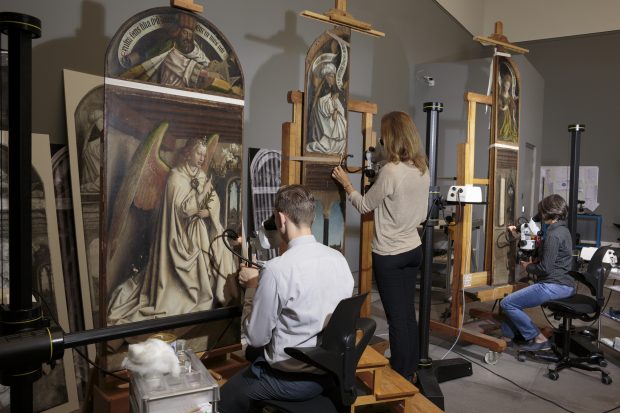
But, as de Zegher explains to me when we meet, her plans involve a much more radical rethink of the Museum of Fine Arts’ identity. ‘I’ve always felt this was a museum with great potential,’ she says tactfully. It boasts a fine building and an exceptional collection of historical art and could easily have rested on its laurels, content to be a solid and dependable municipal gallery, but remote from the people it served. De Zegher’s vision, on the other hand, is to open up the museum in the broadest sense – to make it more accessible and inclusive, to instil a culture that embraces new ideas and approaches, but also to be more socially and politically engaged.
The senior curator, Bruno Fornari, gives me a tour of the collection, beginning with the museum’s oldest pieces, in a gallery hung with large altarpieces and sacred works by Dutch and Flemish artists such as Maarten van Heemskerck and Maerten De Vos. Fornari tells me that the origins of the collection go back to 1798, when the French government established a museum in the provincial capital of Ghent to hold works taken from monasteries and churches that had been dissolved or destroyed around the time of the French Revolution. In 1811 this collection, which numbered over 200 works, was transferred to Ghent Academy of Fine Arts, where it served as a reference and teaching resource for the Academy’s students. Thus, from early on in its history the collection has had a close connection with contemporary art practice in the city, Fornari explains.
Beginning in 1837, the City of Ghent started adding to the collection by purchasing contemporary art at the Ghent Salon and at Salons in other cities, and large numbers of Belgian and French works were acquired in this way. The Paris art scene had a strong influence on Belgian tastes in this period. A recurrent theme throughout the collection is the way in which Ghent and the wider Flemish region has long been a hub for cultural exchanges across Europe. Burgundy was at the centre of important international networks in the days of Van Eyck, for example. Then in the early 17th century, a number of Ghent and Antwerp artists, such as Jan Janssens and Theodoor Rombouts, developed a localised Caravaggist style, assimilating the new pictorial language brought back from Rome. This will be the subject of an exhibition in the museum in 2018.
Jupiter and Antiope , (c. 1620), Anthony Van Dyck. Museum of Fine Arts Ghent
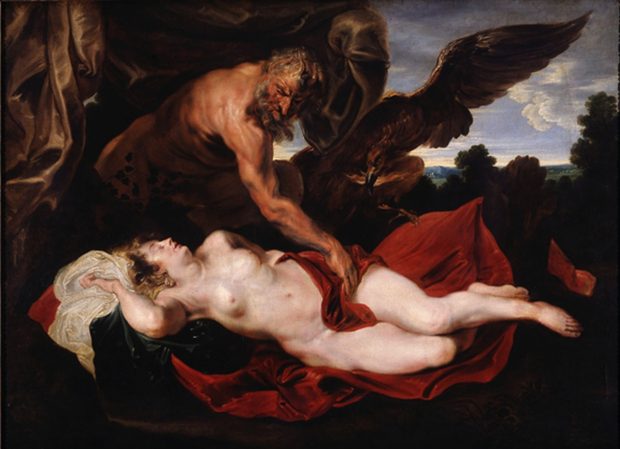
At the end of the 19th century, Belgium experienced a flourishing of cultural life, with Brussels in particular emerging as an international centre for avant-garde art and art nouveau design, developments which are referred to as the Belgian fin de siècle. In Ghent, a group of wealthy connoisseurs and collectors responded to this new mood of cultural dynamism by establishing in 1897 the ‘Friends of the Museum’, an organisation that helped expand the collection through purchases, donations, and bequests. The new acquisitions reflected the eclectic tastes of the art-loving Ghent bourgeoisie, embracing art by modern Belgian artists, but also works by Old Masters. Two panels that the museum attributes to Hieronymus Bosch entered the collection in the first decade of the 20th century: St Jerome in Prayer (c. 1500) and Christ Carrying the Cross (1510–16), plus important paintings by Tintoretto, Frans Hals, Rubens, Jacob Jordaens, and Anthony Van Dyck. In some cases it was the Old Master acquisitions rather than the contemporary art that sparked controversy. Ghent polite society was scandalised by the fleshy eroticism and voyeuristic connotations of Van Dyck’s Jupiter and Antiope (c. 1620), for example, insisting the painting be removed from public view.
The museum purchased some masterpieces relatively cheaply. Théodore Géricault’s Portrait of a Kleptomaniac (c. 1820–24) was bought for a bargain price at a Parisian auction in 1908. At the time, it went under the title The Mad Murderer, and the local press speculated as to who would be fool enough to hang such a picture in their home. One of 10 studies Géricault made of mentally ill patients in an asylum, it is now one of the best-loved paintings in the collection, admired for the way it balances objectivity with an empathetic connection between painter and sitter. The portrait was the centrepiece of an exhibition in the museum in 2014: ‘Géricault: Fragments of Compassion’.
As the collection expanded it soon became clear that a new home for the museum would be needed. The Friends persuaded the city authorities to erect a purpose-built museum in Ghent’s Citadel Park. Designed by Charles Van Rysselberghe, brother of the painter Théo Van Rysselberghe, the new building was completed in 1913. It is a fine example of museum architecture: arranged over a single floor, with spacious galleries lit by natural light from above. The entrance is a neoclassical colonnaded portico, as befits a temple of art, but overall it is not a grandiose building: ‘The jewellery box must never exceed the jewellery inside,’ said Charles Van Rysselberghe.
Mary-Magdalene , (1887), Alfred Stevens. Museum of Fine Arts Ghent
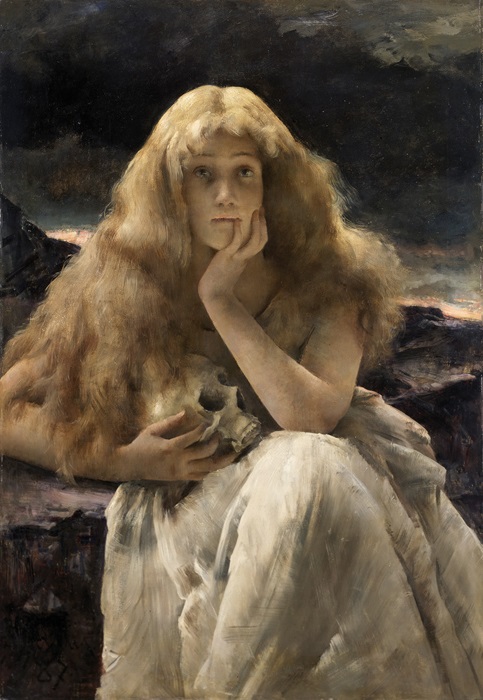
After the First World War, the Belgian art scene became a focal point for Expressionism, looking towards Germany rather than Paris. The museum holds notable works of Flemish Expressionism, by artists such as Constant Permeke, Frits Van den Berghe, and Gustave De Smet, alongside pieces by the German and Austrian artists Ernst Ludwig Kirchner, Erich Heckel, and Oskar Kokoschka. The collecting policy since the Second World War has been largely directed towards 19th- and early 20th-century art and acquiring representative works by Belgian artists or international figures who exerted a strong influence on Belgian art. However, with this focus on the art of the past the museum has lost touch with living artists, which had been such an important aspect of its earlier history.
Catherine de Zegher describes the tendency of museums to divide everything up into periods, categories, and genres as ‘institutional bureaucracy’, and one of the main barriers to greater openness. Nowhere is this more so than in the artificial distinction between historical and contemporary art. She describes this as ‘a false caesura: an unfortunate and erroneous rupture’. She continues: ‘It is our mission to heal historical and contemporary institutions of such a caesura, to make the divided whole again.’ For the Museum of Fine Arts Ghent this does not imply heading off in a new direction, but rediscovering something it has lost. ‘We have always been an avant-garde museum,’ de Zegher explains.
The museum’s sister institution, the Munipical Museum of Contemporary Art (the Stedelijk Museum voor Actuele Kunst, affectionately known as ‘SMAK’), is located on the opposite side of the road from the Museum of Fine Arts. SMAK was founded in 1975; the first public museum devoted to contemporary art in Belgium, and was born out of an awareness that contemporary art was being neglected within the art establishment. It was provisionally housed within the Museum of Fine Arts building, an unsatisfactory co-habitation that persisted for over 20 years until SMAK was given its own home in a new building nearby in 1999. De Zegher ruefully observes that no sooner had this division occurred than the idea was already becoming outmoded. ‘The tendency in the 21st century is to bring things together,’ she says, ‘so now we find ourselves trying to undo all of these artificial separations and working together again.’ There is talk of one day reconfiguring the two institutions within an ‘island of museums’ integrated within their parkland setting.
The museum receives most of its core funding from the City of Ghent – ‘one of the last socialist municipalities in Belgium’, de Zegher wryly informs me. Further support comes from the Flemish Community (the regional devolved administration). But public funds are insufficient to support all of the museum’s plans. Having worked in the US – de Zegher was Director of the Drawing Center in New York from 1999 to 2006 – she is comfortable with exploring ways of generating income and attracting commercial and philanthropic support. But she stresses that her approach is a collaborative one, to present the museum as a potential partner looking to develop mutually beneficial relationships. The idea of creating partnerships, for example, with a technology company or with the local university, is another aspect of being a ‘socially engaged’ museum.
The Absinthe Drinker , (1907), Léon Spilliaert. Museum of Fine Arts Ghent
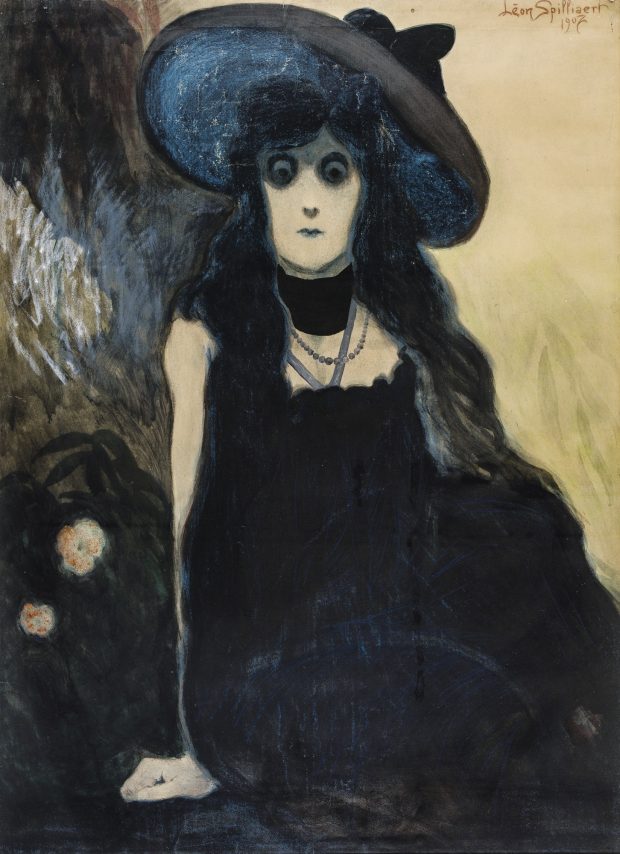
The museum’s funds for acquisitions are limited. The Flemish Community has a commitment to protect some artworks designated as Flemish cultural heritage. The King Baudouin Foundation (an independent philanthropic body) also has resources to acquire art on behalf of Belgium’s museums, and in 2015 purchased Léon Spilliaert’s The Absinthe Drinker (1907) for the museum. Relationships with collectors continue to be important: in 2015 James Ensor’s The Melancholy Fishwives (1892) was bought by a private collector for $7 million, a record for a work by Ensor, and is currently on loan to the museum for at least two years.
De Zegher’s energy for developing innovative and interesting ways of working with the collection is clear. Early in 2017, the museum will present an exhibition called ‘EyeWitness’ which will feature a recently acquired set of Francisco de Goya’s The Disasters of War (1810–20) prints. These will be shown with several drawings, paintings, prints, and videos by the Iranian artist Farideh Lashai (1944–2013), including an animated digital piece When I Count, There Are Only You…But When I Look, There is Only a Shadow (2013) which was inspired by Goya’s series. The exhibition will explore how the two artists, separated by two centuries and from two very different cultures, have witnessed oppression and chronicled conflict in their art.
Later in 2017, the museum will host the concluding exhibition of a two-year collaborative project entitled ‘Manufactories of caring space-time’. Co-funded by the European Commission within the Creative Europe Programme, this venture has involved three cultural institutions – the Museum of Fine Arts in Ghent, the 49 Nord 6 Est FRAC Lorraine in Metz, and the Fundació Antoni Tàpies in Barcelona – all of which have worked with their local communities and with artists collectives to create participative art practices, exhibitions, and performances which have then been staged in the three locations. De Zegher relishes the disruptive potential of the project, which will introduce alternative approaches to narrative and knowledge and new ways of experiencing and seeing art in the museum. ‘Fundamentally the project is about caring,’ she says, ‘how we care for each other, for objects, for our past.’
When I ask de Zegher whether she has met much resistance to the ‘open museum’ concept, she smiles. ‘It takes time,’ she says. ‘People understand the need to be more inclusive, but some are wary about the consequences. You have to get people on board; it takes a lot of dialogue. But it’s important to define clearly your vision and mission. We went through that process last year – talking to each department and understanding how each person fits into the whole.’ She stresses that the concept of an ‘open museum’ isn’t a fixed destination, that the discussions are an essential part of developing the museum’s identity.
In 2014, de Zegher launched a ‘five-year plan’ to revitalise the presentation of the permanent collection. The results are not as radical as one might expect, given our discussion so far. The hang has been made more logical, arranged in a chronological succession with some thematic clusters where the collection has particular strengths, in flower paintings, say, or 19th-century landscapes. One innovation in the redesign has been to move away from a ‘white box’ approach by introducing more three-dimensional elements into the galleries. For example, antique furniture borrowed from the design museum has been placed in some rooms to invoke the domestic interiors in which many of the pictures were originally displayed.
One of the largest spaces, a semi-circular gallery in the centre of the building, currently provides a venue for a site-specific installation, Metafloristik, by the Swiss artists Gerda Steiner and Jörg Lenzlinger. An assemblage of natural and manmade objects that hang from the ceiling and rise up from the floor, the piece creates a synthetic garden which the viewer can explore, a fantasy realm which has the dreamlike quality of combining the familiar with the strange.
Around this gallery, a suite of eight small rooms has been remodelled as a dedicated ‘Drawing Cabinet’, to allow the museum to display items from its collection of 6,000 works on paper. In keeping with de Zegher’s desire to break up the empty spaces of the museum, these rooms have been furnished with bespoke desks, cases, and sets of drawers, which replicate the traditional way in which drawing collections are housed and to encourage more intimate engagement with the works on paper.
The Reading by Émile Verhaeren , (1903), Théo Van Rysselberghe. Musuem of Fine Arts Ghent
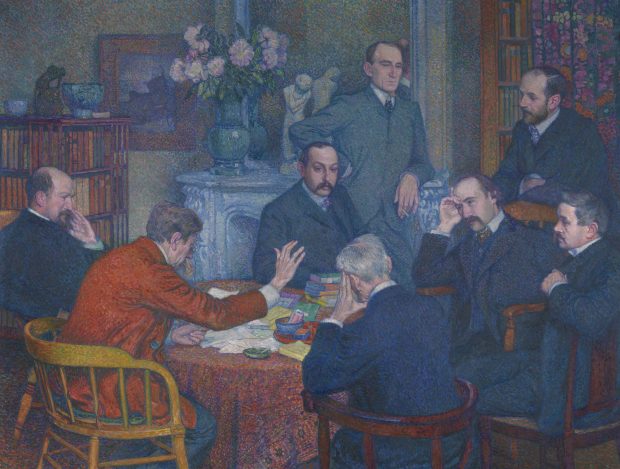
The inaugural exhibition in the Drawing Cabinet is devoted to the Belgian poet and critic Émile Verhaeren (‘The writer, critic and the art of his time, 1881–1916’, until 15 January). An internationally renowned writer and a key figure in artistic and intellectual circles in Belgium at the turn of the 20th century, Verhaeren became the spokesperson of the artistic revival and a defender of modernity. Drawing on the museum’s exceptional holdings of fin de siècle paintings, sculpture, and works on paper, the exhibition reconstructs the cultural milieu in which Verhaeren operated. Artists represented include Constantin Meunier, James Ensor, Théo Van Rysselberghe, Paul Signac, Fernand Khnopff, George Minne, and Odilon Redon.
Returning to the Ghent Altarpiece, de Zegher says that the restoration project is due to be completed in 2019, in time for a major exhibition in the museum the following year, which has been given the working title, ‘Jan van Eyck and the Court of the Dukes of Burgundy’. It is an ambitious undertaking, aiming to bring together as many works as possible by Van Eyck and his contemporaries. An exhibition of this scope will do much to raise the international profile of the museum and de Zegher and her colleagues are clearly excited by the prospect. But she also sounds a note of caution: ‘A successful museum is not just about blockbusters.’ Whereas many museum directors would be happy to see visitors queuing around the block de Zegher is more interested in the quality of the experience inside the museum. For her, the ‘open museum’ is about much more than pulling in the crowds; it is about making connections – connecting the past with the present, connecting different cultures and experiences, and connecting the museum in lively and innovative ways with the communities it serves.
From the January issue of Apollo. Preview and subscribe here.



